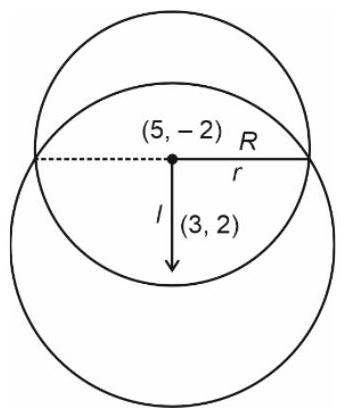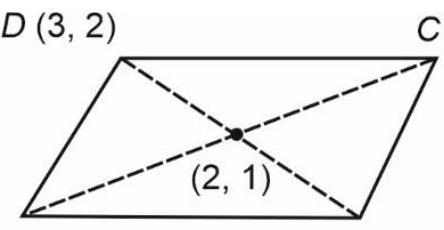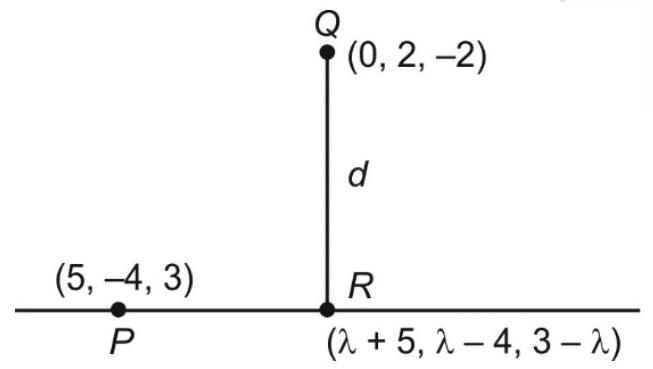Jee Main 2024 31 01 2024 Shift1
Question 1
Sum of series $\frac{1}{1-3 \cdot 1^{2}+1^{4}}+\frac{2}{1-3 \cdot 2^{2}+2^{4}}$
$+\frac{3}{1-3 \cdot 3^{2}+3^{4}}+\ldots$ upto 10 terms is
(1) $\frac{-55}{109}$
(2) $\frac{55}{109}$
(3) $\frac{45}{109}$
(4) $\frac{-45}{109}$
Show Answer
Answer: (1)
Solution:
General term of series
$$ \Rightarrow \quad T _r=\frac{r}{1-3 r^{2}+r^{4}} $$
$$ \begin{aligned} & =\frac{r}{\left(r^{4}-2 r^{2}+1\right)-r^{2}}=\frac{r}{\left(r^{2}-1\right)^{2}-r^{2}} \\ & =\frac{r}{\left(r^{2}-r-1\right)\left(r^{2}+r-1\right)}=\frac{\frac{1}{2}\left[\left(r^{2}+r-1\right)-\left(r^{2}-r-1\right)\right]}{\left(r^{2}-r-1\right)\left(r^{2}+r-1\right)} \\ & =\frac{1}{2}\left[\frac{1}{r^{2}-r-1}-\frac{1}{r^{2}+r-1}\right] \end{aligned} $$
Sum of 10 terms $\Rightarrow$
$\sum _{r=1}^{10} T _r=\frac{1}{2}\left[\frac{1}{-1}-\frac{1}{1}\right]+\frac{1}{2}\left[\frac{1}{1}-\frac{1}{5}\right]+\frac{1}{2}\left[\frac{1}{5}-\frac{1}{11}\right]+\ldots$
$$ +\frac{1}{2}\left[\frac{1}{89}-\frac{1}{109}\right] $$
Telescopic sum
$$ \Rightarrow \frac{1}{2}\left[-1-\frac{1}{109}\right]=\frac{1}{2}\left(\frac{-110}{109}\right)=\frac{-55}{109} $$
Question 2
If one of the diameter of the circle $x^{2}+y^{2}-10 x+4 y$ $+13=0$ is a chord of another circle and whose centre is the point of intersection of the lines $2 x+$ $3 y=12$ and $3 x-2 y=5$, then the radius of the circle is
(1) 6
(2) $3 \sqrt{2}$
(3) $\sqrt{20}$
(4) 4
Show Answer
Answer: (1)
Solution:

$2 x+3 y=12$
$3 x-2 y=5$
Point of intersection $\equiv(3,2)$
$\therefore$ centre is $(3,2)$
$I=\sqrt{4+16}=2 \sqrt{5}$
$R^{2}+R^{2}=r^{2}$
$\Rightarrow 20+(25+4-13)=r^{2}$
$\Rightarrow 20+16=r^{2}$
$\Rightarrow r=6$
Question 3
An urn contains 15 red, 10 white, 60 orange and 15 green balls. 2 balls are taken with replacement. Find the probability 1 ball is red and other ball is white.
(1) $\frac{2}{27}$
(2) $\frac{3}{22}$
(3) $\frac{1}{33}$
(4) $\frac{1}{29}$
Show Answer
Answer: (3)
Solution:
Total balls in urn $=15+10+60+15=100$ balls 2 balls are taken with replacement
So, probability that 1 ball is red and
1 ball is white $=\frac{{ }^{15} C _1 \times{ }^{10} C _1}{{ }^{100} C _2}$
$\frac{15 \times 10 \times 2}{100 \times 99}=\frac{300}{100 \times 99}=\frac{3}{99}=\frac{1}{33}$
Question 4
$\lim _{x \rightarrow 0} \frac{e^{|2 \sin x|}-2|\sin x|-1}{x^{2}}$ is
(1) D.N.E
(2) 2
(3) 1
(4) -1
Show Answer
Answer: (2)
Solution:
$\lim _{x \rightarrow 0} \frac{e^{|2 \sin x|}-2|\sin x|-1}{x^{2}}$
$$ =\lim _{x \rightarrow 0} \frac{1+|2 \sin x|+\frac{|2 \sin x|^{2}}{2}+\ldots \infty-2|\sin x|-1}{x^{2}} $$
$=\lim _{x \rightarrow 0} \frac{2 \sin ^{2} x+\ldots}{x^{2}}$
$=2$
Question 5
Number of all 4 letter words formed by the word “DISTRIBUTION’ is
(1) 2138
(2) 2976
(3) 3734
(4) 2856
Show Answer
Answer: (3)
Solution:
4 letter words formed by
DISTRIBUTION
$D \rightarrow 1$
I $\rightarrow 3$
$S \rightarrow 1$
$T \rightarrow 2$
$R \rightarrow 1$
$B \rightarrow 1$
$U \rightarrow 1$
$O \rightarrow 1$
$N \rightarrow 1$
(i) 4 alike $=0$
(ii) 3 alike +1 diff $={ }^{1} C _1 \times{ }^{8} C _1 \times \frac{4 !}{3 !}$
(iii) $2 A B C$ type
$\Rightarrow{ }^{2} C _1 \cdot{ }^{8} C _2 \cdot \frac{4 !}{2 !}$
(iv) $2 A 2 B={ }^{2} C _2 \cdot{ }^{4} C _2$
(v) $A B C D$ type : ${ }^{9} C _4 \times 4$ !
$\Rightarrow$ Total $=3734$
Question 6
Let $\vec{a}=3 \hat{i}+\hat{j}-2 \hat{k}, \vec{b}=4 \hat{i}+\hat{j}+7 \hat{k}$ and $\vec{c}=\hat{i}-3 \hat{j}+4 \hat{k}$ be 3 vector. If a vector $\vec{p}$ satisfiers $\vec{p} \times \vec{b}=\vec{c} \times \vec{b}$ and $\vec{p} \cdot \vec{a}=0$, then $\vec{p} \cdot(\hat{i}-\hat{j}-\hat{k})$ is
(1) 32
(2) 23
(3) 16
(4) 61
Show Answer
Answer: (1)
Solution:
$\vec{p} \times \vec{b}-\vec{c} \times \vec{b}=0$
$$ \begin{aligned} & (\vec{p}-\vec{c}) \times \vec{b}=0 \\ & \Rightarrow \vec{b} | \vec{p}-\vec{c} \end{aligned} $$
$\Rightarrow \vec{b}=\lambda(\vec{p}-\vec{c})$
$\Rightarrow k \vec{b}+\vec{c}=\vec{p}$
$\vec{p}=\hat{i}(4 k+1)+\hat{j}(k-3)+\hat{k}(7 k+4)$
$\vec{p} \cdot \vec{a}=0$
$(4 k+1) 3+(k-3) 1+(7 k+4)(-2)=0$
$12 k+3+k-3-14 k-8=0$
$\Rightarrow k=-8$
$\therefore \vec{p}=-31 \hat{i}-11 \hat{j}-52 \hat{k}$
$\vec{p} \cdot(\hat{i}-\hat{j}-\hat{k})=-31+11+52=-31+63$
$=32$
Question 7
The solution of differential equation
$y \frac{d x}{d y}=x\left(\log _e x-\log _e y+1\right), x>0, y>0$ and passing through $(e, 1)$ is
(1) $\left|\log _e\left(\frac{y}{x}\right)\right|=y^{2}$
(2) $2\left|\log _e\left(\frac{x}{y}\right)\right|=y$
(3) $\left|\log _e\left(\frac{y}{x}\right)\right|=x$
(4) $\left|\log _e\left(\frac{x}{y}\right)\right|=y$
Show Answer
Answer: (4)
Solution:
$y \frac{d x}{d y}=x(\ln x-\ln y+1), x>0, y>0$
$\frac{d x}{d y}=\frac{x}{y}\left(\ln \left(\frac{x}{y}\right)+1\right)$
$\frac{x}{y}=t \Rightarrow x=t y$
$\Rightarrow \frac{d x}{d y}=t+y \frac{d t}{d y}$
$\Rightarrow t+y \frac{d t}{d y}=t \ln t+t$
$\Rightarrow \frac{d t}{t \ln t}=\frac{d y}{y}$
$\Rightarrow \ln (\ln t)=\ln y+c$
$\Rightarrow \ln \left(\ln \frac{x}{y}\right)=\ln y+c$
at $x=e, y=1$
$\Rightarrow \ln (\ln e)=\ln 1+C$
$\Rightarrow c=0$
$\Rightarrow \ln \left(\ln \frac{x}{y}\right)=\ln y$ $\Rightarrow \ln \left(\frac{x}{y}\right)=y$
$\left|\log _e\left(\frac{x}{y}\right)\right|=y \quad$ as $y>0$
Question 8
If $f(x)=\frac{4 x+3}{6 x-4}$ and $g(x)=f(f(x))$,
then $g(g(g(g(x))))=$ ?
(1) $x$
(2) $2 x$
(3) $-x$
(4) $-2 x$
Show Answer
Answer: (1)
Solution:
$f(x)=\frac{4 x+3}{6 x-4}$
$g(x)=f(f(x))$
$=\frac{4\left(\frac{4 x+3}{6 x-4}\right)+3}{6\left(\frac{4 x+3}{6 x-4}\right)-4}=\frac{16 x+12+18 x-12}{24 x+18-24 x+16}$
$=\frac{34 x}{34}=x$
$g(g(g(g(x))))=x$
Question 9
If $f(x)=\left|\begin{array}{ccc}x^{3} & 2 x^{2}+1 & 1+3 x \\ 3 x^{2}+2 & 2 x & x^{3}+6 \\ x^{3}-x & 4 & x^{2}-2\end{array}\right|$, then the value of $2 f(0)+f^{\prime}(0)$ is equal to
(1) 18
(2) 54
(3) 48
(4) 42
Show Answer
Answer: (4)
Solution:
$f^{\prime}(x)=\left|\begin{array}{ccc}3 x^{2} & 2 x^{2}+1 & 1+3 x \\ 6 x & 2 x & x^{3}+6 \\ 3 x^{2}-1 & 4 & x^{2}-2\end{array}\right|+$
$$ \left|\begin{array}{ccc} x^{3} & 4 x & 1+3 x \\ 3 x^{2}+2 & 2 & x^{3}+6 \\ x^{3}-x & 0 & x^{2}-2 \end{array}\right|+\left|\begin{array}{ccc} x^{3} & 2 x^{2}+1 & 3 \\ 3 x^{2}+2 & 2 x & 3 x^{2} \\ x^{3}-x & 4 & 2 x \end{array}\right| $$
Now, $f(0)=\left|\begin{array}{lll}0 & 1 & 1 \\ 2 & 0 & 6 \\ 0 & 4 & -2\end{array}\right|=12$
and $f^{\prime}(0)=\left|\begin{array}{ccc}0 & 1 & 1 \\ 0 & 0 & 6 \\ -1 & 4 & -2\end{array}\right|+\left|\begin{array}{ccc}0 & 0 & 1 \\ 2 & 2 & 6 \\ 0 & 0 & -2\end{array}\right|+\left|\begin{array}{lll}0 & 1 & 3 \\ 2 & 0 & 0 \\ 0 & 4 & 0\end{array}\right|$
$$ =-6+0+24=18 $$
$\Rightarrow 2 f(0)+f^{\prime}(0)=2 \times 12+18=42$
Question 10
$A B C D$ is a parallelogram where $A(\alpha, \beta), B=(1,0)$, $C(\gamma, \rho)$ and $D(3,2)$ and $A B=\sqrt{10}$. The value of $2(\alpha$ $+\beta+\gamma+\rho)$ is equal to
(1) 8
(2) 10
(3) 12
(4) 16
Show Answer
Answer: (3)
Solution:

$A(\alpha, \beta)$
B $(1,0)$
Using mid point formula
$\alpha+\gamma=4$
$\beta+\rho=2$
$\alpha+\beta+\gamma+\rho=6$
$\therefore 2(\alpha+\beta+\gamma+\rho)=12$
Question 11
Let $g(x)$ be a linear function and
$f(x)=\begin{array}{cl}g(x), & x \leq 0 \\ \left(\frac{x+1}{x+2}\right)^{\frac{1}{x}}, & x>0\end{array}.$, iscontinuous at $x=0$.
If $f^{\prime}(1)=f(-1)$ then the value of $g(3)$ is
(1) $\frac{1}{3} \log e^{\left(\frac{4}{9}\right)}+1$
(2) $\frac{1}{3} \log e^{\left(\frac{4}{9 e^{1 / 3}}\right)}$
(3) $\log e^{\left(\frac{4}{9}\right)}-1$
(4) $\log e^{\left(\frac{4}{9 e^{1 / 3}}\right)}$
Show Answer
Answer: (4)
Solution:
Let $g(x)=p x+q$
Since $f(x)$ is continuous at $x=0$
$\Rightarrow g(0)=\lim _{x \rightarrow 0^{+}}\left(\frac{x+1}{x+2}\right)^{1 / x}=0$
$\Rightarrow g(x)=p x \quad(q=0)$
Now, $f^{\prime}(1)=f(-1)$
$y=\left(\frac{1+x}{2+x}\right)^{1 / x}$
$\Rightarrow \ln y=\frac{1}{x} \ln \left(\frac{1+x}{2+x}\right)$
$\frac{1}{y} d y=\frac{-1}{x^{2}} \ln \left(\frac{1+x}{2+x}\right)+\frac{1}{x} \times \frac{1}{\left(\frac{1+x}{2+x}\right)} \times \frac{(x+2)-(x+1)}{(2+x)^{2}}$
at $x=1$
$f(1)=\left(\frac{2}{3}\right)\left[-\ln \left(\frac{2}{3}\right)+\frac{3}{2}\left(\frac{1}{9}\right)\right]$
$$ \begin{aligned} & =\frac{-2}{3} \ln \left(\frac{2}{3}\right)+\frac{1}{9} \\ & \Rightarrow f(-1)=-P=\frac{-2}{3} \ln \left(\frac{2}{3}\right)+\frac{1}{9} \\ & \Rightarrow p=\frac{2}{3} \ln \left(\frac{2}{3}\right)-\frac{1}{9} \\ & g(3)=3 p=2 \ln \left(\frac{2}{3}\right)-\frac{1}{3}=\ln \left(\frac{4}{9}\right)+\log e^{(-1 / 3)} \\ & \Rightarrow \ln \left(\frac{4}{9 e^{1 / 3}}\right) \end{aligned} $$
Question 12
The distance of the point $Q(0,2,-2)$ from the line passing through the $P(5,-4,3)$ and perpendicular to the lines $\vec{r}=(-3 \hat{i}+2 \hat{k})+\lambda(2 \hat{i}+3 \hat{j}+5 \hat{k}), \lambda \in R$ and $\vec{r}=(\hat{i}-2 \hat{j}+\hat{k})+\mu(-\hat{i}+3 \hat{j}+2 \hat{k}), \mu \in R$ is
(1) $\sqrt{66}$
(2) $\sqrt{74}$
(3) $\sqrt{56}$
(4) $\sqrt{46}$
Show Answer
Answer: (2)
Solution:
$\vec{\tau}=\left|\begin{array}{ccc}\hat{i} & \hat{j} & \hat{k} \\ 2 & 3 & 5 \\ -1 & 3 & 2\end{array}\right|=\hat{i}(6-15)-\hat{j}(4+5)+\hat{k}(6+3)$
$=-9 \hat{i}-9 \hat{j}+9 \hat{k}$
$\therefore$ Required line $(L): \frac{x-5}{1}=\frac{y+4}{1}=\frac{z-3}{-1}=\lambda$
$x=\lambda+5, y=\lambda-4, z=3-\lambda$

$\overrightarrow{Q R} \cdot \vec{I}=(\lambda+5) \cdot 1+(\lambda-6) \cdot 1+(3-\lambda+2)(-1)=0$
$\Rightarrow \lambda+5+\lambda-6-5+\lambda=0$
$\Rightarrow 3 \lambda=6$
$\Rightarrow \lambda=2$
$\therefore \quad R(7,-2,1)$
$\therefore \quad Q R=\sqrt{49+16+9}$
$=\sqrt{74}$
Question 13
If $\alpha$ denotes the number of real solutions of $(1-i)^{x}$ $=2^{x}$ and $\beta=\frac{|z|}{\arg z}$,
where $\quad z=\frac{\pi}{4}(1+i)^{4}\left[\frac{1-\sqrt{\pi i}}{\sqrt{\pi}+i}+\frac{\sqrt{\pi}-i}{1+\sqrt{\pi i}}\right], \quad i=\sqrt{-1}$ then distance of $(\alpha, \beta)$ from the line $4 x-3 y-7=0$ is
(1) 2
(2) 3
(3) 7
(4) 4
Show Answer
Answer: (2)
Solution:
$z=\frac{\pi}{4}(1+i)^{4}\left[\frac{1+\pi+\pi+1}{i(1+\pi)-\sqrt{\pi}+\sqrt{\pi}}\right]$
$=\frac{\pi}{4}(1+i)^{4} \frac{2}{(i)}=\frac{\pi}{2} \frac{(1+i)^{4}}{i}=\frac{-\pi}{2} i(1+i)^{4}$
$|z|=\left|-\frac{\pi}{2}\right||i||1+i|^{4}=\left(\frac{\pi}{2}\right)(1)(\sqrt{2})^{4}=2 \pi$
$z=\frac{-\pi}{2}(-4 i)=2 \pi i \Rightarrow \arg (z)=\frac{\pi}{2}$
$\Rightarrow \beta=\frac{2 \pi}{\frac{\pi}{2}}=4$
Also, $(1-i)^{x}=2^{x}$
$\Rightarrow$ Taking modulus both sides
$\Rightarrow(\sqrt{2})^{x}=2^{x} \Rightarrow(\sqrt{2})^{x}=0$
$\Rightarrow$ at $x=0$
$\Rightarrow 1$ solution $\Rightarrow \alpha=1$
$\Rightarrow$ Perpendicular distance from $(1,4)$
$\left|\frac{4(1)-3(4)-7}{5}\right|=\left|\frac{4-12-7}{5}\right|=3$
Question 14
Let $S$ be the set of positive integral values of ’ $a$ ’ for which $\frac{a x^{2}+2(a+1) x+9 a+4}{x^{2}-8 x+32}<0 \quad \forall x \in \mathbb{R}$
Then the number of elements in $S$ is
(1) 1
(2) 3
(3) 0
(4) $\infty$
Show Answer
Answer: (3)
Solution:
Given $\frac{a x^{2}+2(a+1) x+9 a+4}{x^{2}-8 x+32}<0 \quad \forall x \in \mathbb{R}$
In $x^{2}-8 x+32$, we have $D=64-128<0$
$\therefore x^{2}-8 x+32>0 \quad \forall x \in \mathbb{R}$ $\Rightarrow a x^{2}+2(a+1) x+9 a+4<0 \quad \forall x \in \mathbb{R}$
$\Rightarrow a<0$ and $D<0$
$\because$ Question has asked for positive integral values of $a$
$\therefore \quad|S|=0$
Question 15
For $\alpha, \beta \gamma>0$, if $\sin ^{-1} \alpha+\sin ^{-1} \beta+\sin ^{-1} \gamma=\pi$ and $(\alpha$ $+\beta+\gamma)(\alpha-\gamma+\beta)=3 \alpha \beta$, then $\gamma$ is
(1) $-\left(\frac{\sqrt{3}-1}{2 \sqrt{2}}\right)$
(2) $\frac{-1}{\sqrt{2}}$
(3) $-\sqrt{3}$
(4) $\frac{\sqrt{3}}{2}$
Show Answer
Answer: (4)
Solution:
Let $\sin A=\alpha$
$$ \begin{aligned} & \sin B=\beta \\ & \sin C=\gamma \\ & A+B+C=\pi \\ & \Rightarrow(\alpha+\beta)^{2}-\gamma^{2}=3 \alpha \beta \\ & \Rightarrow \alpha^{2}+\beta^{2}-\alpha \beta=\gamma^{2} \\ & \Rightarrow \alpha^{2}+\beta^{2}-\gamma^{2}=\alpha \beta \\ & \Rightarrow \frac{\alpha^{2}+\beta^{2}-\gamma^{2}}{2 \alpha \beta}=\frac{1}{2} \\ & \Rightarrow \cos C=\frac{1}{2} \Rightarrow C=60^{\circ} \\ & \Rightarrow \sin C=\frac{\sqrt{3}}{2}=\gamma \end{aligned} $$
Question 16
In the expansion of
$(1+x)\left(1-x^{2}\right)\left(1+\frac{3}{x}+\frac{3}{x^{2}}+\frac{1}{x^{3}}\right)^{5}$, the sum of coefficients of $x^{3}$ and $x^{-13}$ is
Show Answer
Answer: (118)
Solution:
$(1+x)\left(1-x^{2}\right)\left(1+\frac{3}{x}+\frac{3}{x^{2}}+\frac{1}{x^{3}}\right)^{5}$
$$ \begin{aligned} & \Rightarrow \quad(1+x)^{2}(1-x) \frac{\left(x^{3}+3 x^{2}+3 x+1\right)^{5}}{x^{15}} \\ & \Rightarrow \frac{(1+x)^{2}(1-x)\left[(x+1)^{3}\right]^{5}}{x^{15}}=\frac{(1-x)(1+x)^{17}}{x^{15}} \\ & \Rightarrow \text { Coefficient of } x^{3} \Rightarrow x^{18} \text { in }(1-x)(1+x)^{17} \\ & \Rightarrow(1+x)^{17}-x(1+x)^{17} \\ & \Rightarrow 0-x\left({ }^{17} C _{17} x^{17}\right)={ }^{-17} C _{17}=-1 \end{aligned} $$
and coefficient of $x^{-13} \Rightarrow x^{2}$ in $(1-x)(1+x)^{17}$
$\Rightarrow(1+x)^{17}-x(1+x)^{17}$
$$ \begin{aligned} & \Rightarrow \quad{ }^{17} C _2-{ }^{17} C _1=17 \times 8-17 \\ &=17 \times 7=119 \\ & \Rightarrow \text { sum }=119-1=118 \end{aligned} $$
Question 17
$A={1,2,3,4}, R={(1,2),(2,3),(2,4)} R \subseteq S$ and $S$ is an equivalence relation, then minimum number of elements to be added to $R$ is $n$ then value of $n$ ?
Show Answer
Answer: (13)
Solution:
$R={(1,2),(2,3),(2,4)}$
for reflexive, we need to add,
$(1,1),(2,2),(3,3),(4,4)$
for symmetric
if $(1,2) \in R$
then $(2,1) \in R$
if $(2,3) \in R$
then $(3,2) \in R$
if $(2,4) \in R$
then $(4,2) \in R$
So set becomes
${(1,1),(2,2),(3,3),(4,4),(1,2),(2,1),(2,3),(3,2), (2,4),(4,2)}$
for transitive
As $(1,2) \in R$
$(2,3) \in R$
then $(1,3) \in R$ then $(3,1) \in R$ (for symmetric)
$\&(1,2) \in R$
$(2,4) \in R$
then $(1,4) \in R$ then $(4,1) \in R$ (for symmetric) $(3,2) \in R$
$(2,4) \in R$
then $(3,4) \in R$ then $(4,3) \in R$ (for symmetric)
so set $S={(1,1),(2,2),(3,3),(4,4),(1,2),(2,1),(2,3),(3,2),(2,4),(4,2),(1,3),(3,1),(1,4),(4,1), (3,4),(4,3)}$
so 13 new elements are added
$\Rightarrow n=13$
Question 18
If $|\vec{a}|=1,|\vec{b}|=4$ are $\vec{a} \cdot \vec{b}=2$
also, $\vec{c}=(3 \vec{a} \times \vec{b})-\vec{b}$ and $\alpha$ is the angle between
$\vec{b}$ and $\vec{c}$ then the value of $192 \sin ^{2} \alpha$.
Show Answer
Answer: (167)
Solution:
$|\vec{c}|^{2}=9(|\vec{a} \times \vec{b}|)^{2}+|\vec{b}|^{2}+0$
$|\vec{c}|^{2}=9(16-4)+16$
$$ {\because|\vec{a} \times \vec{b}|^{2}=|\vec{a}|^{2}|\vec{b}|^{2}-(\vec{a} \cdot \vec{b})^{2} } $$
$|\vec{C}|^{2}=124$
$|\vec{c}|=\sqrt{124}$
$\vec{c}=(3(\vec{a} \times \vec{b}))-\vec{b}$
$\vec{c} \cdot \vec{b}=-|\vec{b}|^{2}=-16$
$4 \times \sqrt{124} \cos \alpha=-16$
$\cos \alpha=\frac{-4}{\sqrt{124}}=\frac{-2}{\sqrt{31}}$
$\sin \alpha=\sqrt{1-\frac{4}{31}}$
$\sin \alpha=\sqrt{\frac{27}{31}}$
Then, $192 \sin ^{2} \alpha=192 \times \frac{27}{31}$
$\approx 167.2$
Question 19
If the system of linear equation $x-2 y+z=-4,2 x$ $+\alpha y+3 z=5 \& 3 x-y+\beta z=3$ has infinitely many solutions then $12 \alpha+13 \beta$ is equal to
Show Answer
Answer: (58)
Solution:
$x-2 y+z=-4$
$2 x+\alpha y+3 z=5$
$3 x-y+\beta z=3$
$\Delta _2=\left|\begin{array}{ccc}1 & -4 & 1 \\ 2 & 5 & 3 \\ 3 & 3 & \beta\end{array}\right|=0$
$(5 \beta-9)+4(2 \beta-9)-9=0$
$13 \beta=54$
$\beta=\frac{54}{13}$
$\Delta _3=\left|\begin{array}{ccc}1 & -2 & -4 \\ 2 & \alpha & 5 \\ 3 & -1 & 3\end{array}\right|=0$
$(3 \alpha+5)+2(-9)-4(-2-3 \alpha)=0$
$3 \alpha+5-18+8+12 \alpha=0$
$\Rightarrow \alpha=\frac{1}{3}$
$12 \alpha+13 \beta=4+13 \times \frac{54}{13}$
$=58$










